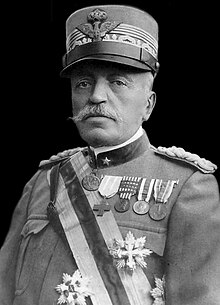Luigi Cadorna
Marshal Count Luigi Cadorna (* 4. September 1850 in Pallanza , Piedmont ; † 23. December 1928 in Bordighera , Liguria ) chief was of the Italian General Staff in the First World War .
Life
His father Raffaele Cadorna the Elder was a senior Italian officer. Luigi Cadorna took over the post of Chief of Staff during the First World War from General Alberto Pollio , who died unexpectedly in July 1914, and headed the Comando Supremo in Udine from the beginning of the war until November 1917 .
Cadorna carried out four offensives on the Isonzo in 1915 . The destination was the city of Gorizia . It blocked the way to Trieste and Laibach . All four offensives failed, Italy suffered large losses of around 250,000 men and hardly gained any ground. Gorizia was not conquered until the beginning of August 1916 in the Sixth Isonzo Battle . By 1917 Cadorna had opened a total of eleven offensives on the Isonzo and also in the Dolomites and on the Asiago plateau in the Ortigara battle.
On October 24, 1917, an offensive initiated by German and Austro-Hungarian associations broke through the Italian lines in the so-called Twelfth Isonzo Battle near Caporetto and reached the Piave River on November 12 . The Italian army was on the verge of disintegration and collapse; the losses in man and material were enormous. Cadorna contributed much to this defeat. He had set up his troops too aggressively, with few reserves in the hinterland. His officers, especially Pietro Badoglio , also turned out to be incompetent.
Cadorna was withdrawn from command of the Italian troops and he was assigned to the Supreme War Council of the Allies as the Italian representative . He held this position until March 1918. His successor as Chief of Staff was General Armando Diaz . In 1919, after an investigation into the defeat of Karfreit / Caporetto, the government and parliament deprived him of his rank and salaries.
In the period that followed, Cadorna supported Mussolini's fascist movement . Mussolini rehabilitated Cadorna in 1924 and promoted him and Armando Diaz to Marshal .
The officer and later resistance fighter Raffaele Cadorna the Younger was Luigi Cadorna's son.
Afterlife
An Italian cruiser built from September 1930 to September 1931 and put into service on August 11 was named Luigi Cadorna . In Bolzano , the street leading north from the headquarters of the mountain troops is dedicated to him . On the Strada delle 52 Gallerie , one of the most famous Italian military roads of the First World War, one of the 52 tunnels was named after him.
Today there are efforts to rename the streets named after him because he could not be a role model in his ruthless, bloody warfare. Already Antonio Gramsci had the Cadornismo spoken as inhuman military strategy.
literature
- The small encyclopedia , Encyclios-Verlag, Zurich, 1950, volume 1, page 262
Web links
- Newspaper article about Luigi Cadorna in the 20th century press kit of the ZBW - Leibniz Information Center for Economics .
Individual evidence
- ↑ Background article on huffingtonpost.it, accessed November 2015
| personal data | |
|---|---|
| SURNAME | Cadorna, Luigi |
| BRIEF DESCRIPTION | Italian chief of staff |
| DATE OF BIRTH | September 4, 1850 |
| PLACE OF BIRTH | Pallanza |
| DATE OF DEATH | December 23, 1928 |
| Place of death | Bordighera |
